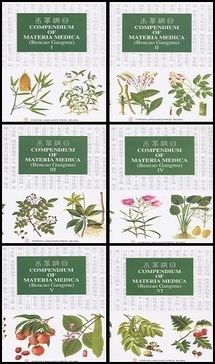8 /10 1 Votes
4/5 Goodreads Simplified Chinese 本草纲目 Wade–Giles Pen-ts'ao Kang-mu | 4/5 AbeBooks Traditional Chinese 本草綱目 Hanyu Pinyin Originally published 1596 | |||||||||||||||||||||||||||||||||
 | ||||||||||||||||||||||||||||||||||
Literal meaning Principles and Species of Roots and Herbs Materia medica books Stimuli Responsive Drug Deli, The Organic Chemistr, Closed‑form Solutions for Drug T, Synthesis of Essential Drugs, From Earth to Herbalist | ||||||||||||||||||||||||||||||||||
compendium of materia medica
The Compendium of Materia Medica, also known by the romanizations Bencao Gangmu or Pen-tsao Kang-mu, is a Chinese materia medica work written by Li Shizhen during the Ming dynasty. It is a work epitomizing the materia medica known at the time. The Compendium of Materia Medica is regarded as the most complete and comprehensive medical book ever written in the history of traditional Chinese medicine. It lists all the plants, animals, minerals, and other items that were believed to have medicinal properties.
Contents
- compendium of materia medica
- Compendium of materia medica
- Name
- History
- Content
- Value
- Errors
- Popular culture
- References
The text consists of 1,892 entries, each entry with its own name called a gang. The mu in the title refers to the synonyms of each name.
The British historian of Chinese science Joseph Needham calls Li Shizhen "the 'uncrowned king' of Chinese naturalists", and his Bencao gangmu "undoubtedly the greatest scientific achievement of the Ming".
Compendium of materia medica
Name
The title, translated as "Materia Medica, Arranged according to Drug Descriptions and Technical Aspects", uses two Chinese compounds. Bencao (Pen-tsao; "roots and herbs; based on herbs, pharmacopeia, materia medica") combines ben (pen; 本 "root; origin; basis") and cao (tsao; 草 "grass; plant; herb"). Gangmu (Kang-mu; "detailed outline; table of contents") combines gang (kang; 綱 "main rope, hawser; main threads, essential principles") and mu (目 "eye; look; category, division").
The characters 綱 and 目 were later used as "class" and "order", respectively, in biological classification.
History
Li Shizhen completed the first draft of the text in 1578, after conducting readings of 800 other medical reference books and carrying out 30 years of field study. For this and many other achievements, Li Shizhen is compared to Shennong, a god in Chinese mythology who gave instruction on agriculture and herbal medicine.
Content
The Compendium of Materia Medica has 53 volumes in total:
- At the very beginning is the table of contents, containing a list of entries included and 1,160 hand drawn diagrams to serve as illustrations.
- Volume 1 to 4 — an 'index' (序例) and a comprehensive list of herbs that would treat the most common sickness (百病主治藥).
- Volume 5 to 53 — the main content of the text, containing 1,892 distinct herbs, of which 374 were added by Li himself. There are 11,096 side prescriptions to treat common illness (8,160 of which is compiled or collected by Li).
The text is written in almost 2 million Chinese characters, classified into 16 divisions and 60 orders. For every herb there are entries on their names, a detailed description of their appearance and odor, nature, medical function, effects and side recipes etc.
Value
With the publication of Compendium of Materia Medica, not only did it improve the classification of how traditional medicine was compiled and formatted, but it was also an important medium in improving the credibility and scientific values of biology classification of both plants and animals.
The compendium corrected many mistakes and misapprehensions of the nature of herbs and diseases. Li also included many new herbs, adding his own discoveries of particular drugs and their efficacity and function, as well as more detailed descriptions of the results of experiments. It also has notes and records on general medical data and medical history.
Compendium of Materia Medica is also more than a mere pharmaceutical text, for it includes a vast amount of information on topics as wide ranging as biology, chemistry, geography, mineralogy, geology, history, and even mining and astronomy, which might appear to have little connection with herbal medicine. It has been translated into more than 20 languages and spread all over the world. Even now it is still in print and used as a reference book.
Errors
Compendium of Materia Medica also contains information that has since been proven to be erroneous due to the contemporary limited scientific and technical knowledge. For example, it is claimed that lead is not toxic. It is also claimed that otters are "always male", and that the Moupin langur is ten feet tall, has backwards feet and can be caught when it draws its upper lip over its eyes.
Popular culture
"Compendium of Materia Medica" is the title of a song performed by the Taiwanese singer Jay Chou in his album Still Fantasy. The lyrics discuss Chinese pride and make references to aspects of Chinese herbal medicine.
